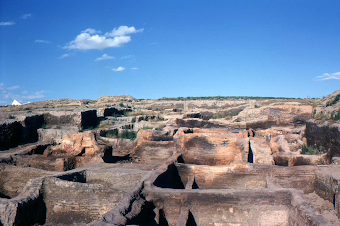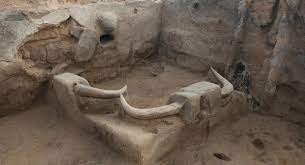Catalhöyük, in modern-day Turkey, is an archaeological marvel that provides an enthralling glimpse into the past. The history of atalhöyük, often regarded as the world's first city, spans over 9,000 years, making it an important site for understanding the early stages of human civilization, settlement patterns, and social organisation. This Neolithic-era city provides invaluable insights into the lives of our distant ancestors and their transition from nomadic hunter-gatherers to settled communities
Historical Significance:Çatalhöyük, which means "forked mound" in Turkish, was first
excavated in the 1960s by British archaeologist James Mellaart. This ancient
settlement, located in the Konya Plain of central Turkey, thrived between
approximately 7500 BCE and 5700 BCE. The city's layout and architectural
features challenge conventional notions of early urban planning and reveal a
complex and tightly-knit society.
Urban Planning and Architecture:The architectural layout of atalhöyük is one of its most striking features. In contrast to later cities that developed streets and thoroughfares, atalhöyük was a dense cluster of mudbrick houses built side by side and atop each other. These houses were rectangular in shape, with flat mud and wooden beam roofs. The houses were accessed through a hole in the roof, and people moved between them via a maze of interconnected passageways and ladders. This one-of-a-kind arrangement suggests a strong sense of community as well as an effort to maximise available space in a small space. These houses' walls were frequently adorned with vibrant murals depicting scenes from everyday life, animals, and symbolic imagery. These murals offer
The Economy and the Way of Life:Agriculture was important in the lives of the people of Atalhöyük. They grew crops like wheat, barley, lentils, and peas and raised livestock like cattle, sheep, and goats. Their survival depended on the fertility of the surrounding Konya Plain, and they developed sophisticated irrigation systems to support their agricultural endeavours.
Social Organization:While the exact nature of the social structure at Çatalhöyük remains a subject of debate among archaeologists, it is clear that the city was home to a relatively large population, possibly numbering in the thousands. The interconnectedness of the houses and the presence of communal spaces suggest a highly cooperative society.The absence of fortifications or evidence of warfare within the city has led scholars to believe that Çatalhöyük may have been a peaceful community. It's possible that disputes and conflicts were resolved through non-violent means, reflecting a sophisticated system of governance and social organization.
Religion and Belief Systems: Catalhöyük provides important insights into its inhabitants' spiritual beliefs. Shrines, often adorned with sculptures and figurines, have been discovered by archaeologists within some of the houses. These findings point to ancestor worship and veneration of natural elements.
The "Mother Goddess" figurine is one of the most famous discoveries at atalhöyük. This tiny clay figurine depicts a woman giving birth and breastfeeding. It is thought to represent the divine's fertility and nurturing aspects. The presence of such figurines suggests a complex belief system that celebrated the life, death, and rebirth cycles.
Decline and Abandonment:Despite its remarkable achievements, Atalhöyük eventually declined and died out around 5700 BCE. The reasons for its decline are still being researched. Some theories point to environmental factors like soil depletion or climate change, while others point to social or economic factors.
Legacy and Continued Research:The legacy of Catalhöyük as one of the world's first cities is undeniable. Its distinctive architectural design, intricate murals, and early urban life evidence have provided a wealth of information about the Neolithic era and the transition to settled communities.Excavations and research at Çatalhöyük continue to this day, shedding new light on the lives and cultures of its ancient residents. As one of humanity's earliest experiments with urban living, Çatalhöyük remains a testament to the ingenuity and adaptability of our ancestors and serves as a crucial piece in the puzzle of human history. It is a UNESCO World Heritage Site and a living testament to the enduring curiosity of archaeologists and historians striving to uncover the mysteries of our past.



Comments
Post a Comment
If you have any doubts